nalco group
bone, muscle & joint pain physio
BOOK NOW / WHATSAPP ABOUT YOUR PAIN OR INJURY
- ORCHARD 400 Orchard Road #12-12 Singapore 238875
- TAMPINES 9 Tampines Grande #01-20 Singapore 528735
- SERANGOON 265 Serangoon Central Drive #04-269 Singapore 550265
Home > Blog > Physiotherapy > Conditions > Shoulder Pain > Shoulder Blade Pain > Scapulothoracic Bursitis
Scapulothoracic Bursitis Physiotherapy
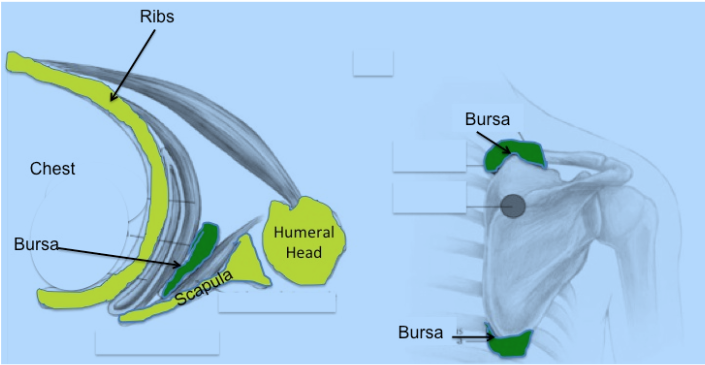
Scapulothoracic bursitis, also medically known as “snapping scapula syndrome”, occurs when there is a problem with how our shoulder blade moves over the rib cage.
If there is presence of inflammation on one of the two scapulothoracic bursae, that sit between the scapula bone and the subscapularis muscle, it'd affect how the shoulder blade (scapula) moves causing
- friction
- weakness and
- pain
Typically, patients complain of a constant, dull ache around the shoulder blade as well as a “snapping” or “grinding” noise and sensation when they move their arm.
Scapulothoracic bursitis is a rare condition, and most of the time, it affects young athletes who do lots of overhead action such as throwing or swimming.
That being said, patients who has had previous shoulder problems such as ligament tears and shoulder arthritis also has increase the risk of developing scapulothoracic bursitis.
first of all...What Is Scapulothoracic Bursitis?
All around our bodies, there are numerous bursa.
They are small fluid filled sacs that act as cushions, providing lubrication between tendons and bones, allowing smooth, friction-free movement.
In the shoulder joint itself, there are 5:
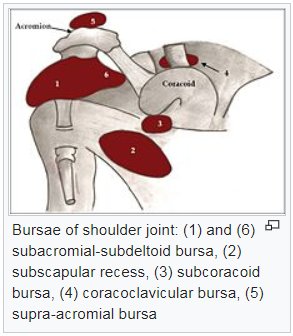
So our subscapularis muscle is a large muscle that sits between the shoulder blade and the rib cage.
Then there are two bursa (known as infraserratus and supraserratus) that sits between the muscle and the bone allowing the shoulder blade to glide over the chest wall freely as the arm moves. One is located at the top of the shoulder blade, the other at the bottom of the shoulder blade.
A very big amount of our shoulder movement comes from the shoulder blade so it is really vital that our shoulder blade can move without restrictions, smoothly and freely.
If there is any form of blockage or weakness in the shoulder blade muscles, it'd gradually cause and aggravate subtle changes in the angle of the shoulder blade which then in turn will affect how it moves (it's a vicious cycle). It then will cause it to start to rub against the rib cage which leads to inflammation of the subscapular bursa and surrounding tissues.
what are the usual Causes Of Snapping Scapula Syndrome
Scapulothoracic bursitis is generally caused by problems with the bones or soft tissues of the rib cage and shoulder blade.
Common causes of snapping scapula syndrome include:
Overuse:
Repetitive friction from overhead activities such as
- throwing as in baseball, cricket, baseball
- weight lifting of heavy weights
- racquet games such as tennis, squash, badminton
- swimming
will irritate the bursa causing inflammation
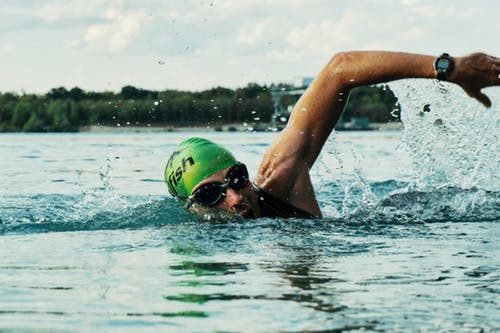
Weakness:
Any forms of muscle weakness means there is less bulk between the ribcage and shoulder blade so they may unfortunately be located or sitting too close to each other...and this, in turn will cause the bones to end up rubbing against each other leading to inflammation.
Posture:
A sustained, kyphosed (forward flexed) posture can lead to weakness of the subscapularis muscle and shift the position of the shoulder blade slightly which makes the bursa prone to friction
Trauma:
Injury to the surrounding area from e.g.
- falls
- direct blows
- motor-vehicle accidents
- sports injuries
Medical Conditions:
Inflammatory conditions such as rheumatoid arthritis increase the risk of developing scapulothoracic bursitis.
Poor Scapular Mobility:
Anything that influences and decreases the free gliding movements of the shoulder blade can increase friction and eventually cause / lead to scapulothoracic bursitis. It may be
- a muscle weakness
- a nerve problem or
- another shoulder problem such as a frozen shoulder
Bony Abnormality:
In some rare situations, if our shoulder blade and / or rib cage bones are somehow rough / not smooth, what will cause more resistance and friction on the surrounding soft tissues.
There may be extra bone growth on the scapula such as:
- a Luschka tubercle (hooked shape prominence on the inner top corner of the scapula)
- a bone tumour such as an osteochondroma or as
- a result of a previous injury such as a rib fracture
what are the Symptoms of Scapulothoracic Bursitis

The most typical symptoms of scapulothoracic bursitis are:
- Snapping: This is probably the most prominent feature of snapping scapula syndrome which is the infamous snapping, grating and/or grinding noise or sensation experienced at the shoulder blade with arm movements
- Pain: Patients typically describe the pain they experience as a constant, dull, aching pain around the shoulder blade and rib cage. This pain tends to get worse with arm movements, particularly when reaching above your head or when doing press ups
- Lump: In some cases, patients may be able to palpate a small lump on the shoulder blade if there is excess bone growth
Your doctor will usually be able diagnose scapulothoracic bursitis by talking to you about your symptoms and observing your shoulder and scapula movements. Your doctors may order an
- x-ray
- MRI or
- CT scan
to confirm the diagnosis and to rule out any other orthopedic issues.
Scapulothoracic Bursitis Conservative management
Thankfully, in most cases, scapulothoracic bursitis can be treated conservatively (without the need for any forms of corrective invasive surgery) with a combination of the following:
1) Rest
Patients has to be extra mindful and avoid aggravating activities and movements, this will reduce the frequency and strain friction and pressure on the bursa. That being said, at the same time, we need to balance with the importance of keeping our shoulder moving within pain limits to prevent it from stiffening up.
If prolonged rest, it may cause shoulder joint stiffness.
2) Medication
Non-steroidal anti-inflammatory medication such as ibuprofen can help to reduce pain and inflammation. Always check with your doctor before taking any medication.
3) Shoulder Blade Physiotherapy
Our senior physiotherapists with partner and work with you on your shoulder to restore normal shoulder blade movement.
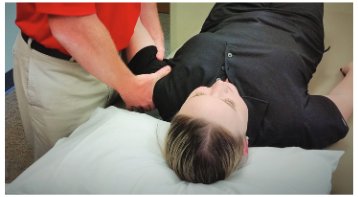
Patients may also receive the following physiotherapy treatment modalities:
- cold therapy
- moist heat paraffin wax therapy
- radio-frequency Indiba physiotherapy to accelerate soft tissue healing
- joint mobilization
- stretching exercises
- strengthening exercises for the rotator cuff muscles
- scar management
- hands on manipulation and mobilization (manual therapy)
- soft tissue management
- heat therapy and heat treatment and heat pack to relief tight muscles and joints
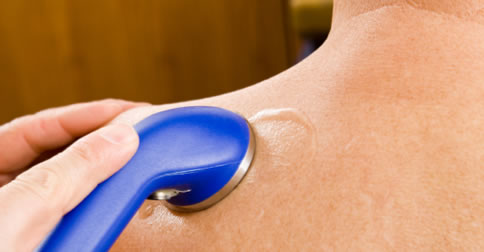
- ultrasound therapy to accelerate soft tissue healing
- exercise therapy
- acupuncture
- dry needling
- deep tissue massage release therapy
- and more
You will need to work on your home exercise program daily for a number of weeks. Your physical therapist will also be able to advise you about correct posture.
4) Steroid Injection
In some cases your shoulder or orthopedic doctor may ask you to consider getting a steroid injection to help to reduce the pain and inflammation from scapulothoracic bursitis. It's a mixture or cortisone and local anaesthetic that is then injected in to the bursa.
Patients typically report that they feel good relief of symptoms and it also confirms diagnosis, as an improvement of symptoms confirms that the symptoms were coming from the bursa.
Of course,. injections should not be used in isolation though - though they do help to reduce the pain and inflammation, if the underlying cause of scapulothoracic bursitis is not addresses, symptoms will most likely return.
5) Cold Or Heat Packs
Many of our patients find that using either a cold pack or a heat pack over the painful or affected shoulder blade will help to ease and reduce their pain.
Please note that any forms of heat therapy or cold therapy should only be used for 10 minutes at a time and you should wait at least 2 hours between applications.
Surgical Treatment
If symptoms of scapulothoracic bursitis have failed to settle with non-operative shoulder physiotherapy treatment then your doctor may advise you to consider corrective shoulder blade surgery.
Most of the time, surgery is performed arthroscopically (key-hole surgery) as a day case, so you can go home the same day.
Surgery may involve one or both of the following:
- Bursectomy: Removal of the inflamed bursa and any surrounding scar tissues
- Partial Scapular Resection: Removal of any bony prominences found on the scapula that may be rubbing on the rib cage. This tends to be the upper border of the inner side of the shoulder blade, known as the superior angle of the scapula. An additional small open incision may be performed when performing the excision depending on your surgeon's preferred technique
Recovering From Scapulothoracic Bursitis Surgery
Following scapulothoracic bursitis corrective surgery, your arm will most likely be immobilized in a sling for up to four weeks (sometimes 1-2 weeks more) to allow the shoulder to heal.
Our senior physiotherapists will work on a graded shoulder and shoulder blade rehab program with you starting with gentle passive stretches and passive exercises (where the weight of the arm is supported) to keep the shoulder moving well and prevent shoulder stiffness from setting in.
Thereafter, you will be progressed to more active ranging and range of motion exercises around 4+ weeks, and by this time you would/should be able to perform most of your day to day activities. Typically, our senior physiotherapists will start to introduce more progressive rehab exercises such as strengthening and resistive exercises around 12+ weeks post operatively.
Good news is that most patients tend to have a very good outcome (surgery and rehab wise) post scapulothoracic bursitis surgery and return to all their usual activities within four or so months.
Source Reference
- Shoulder Pain Explained: https://www.shoulder-pain-explained.com/scapulothoracic-bursitis.html
